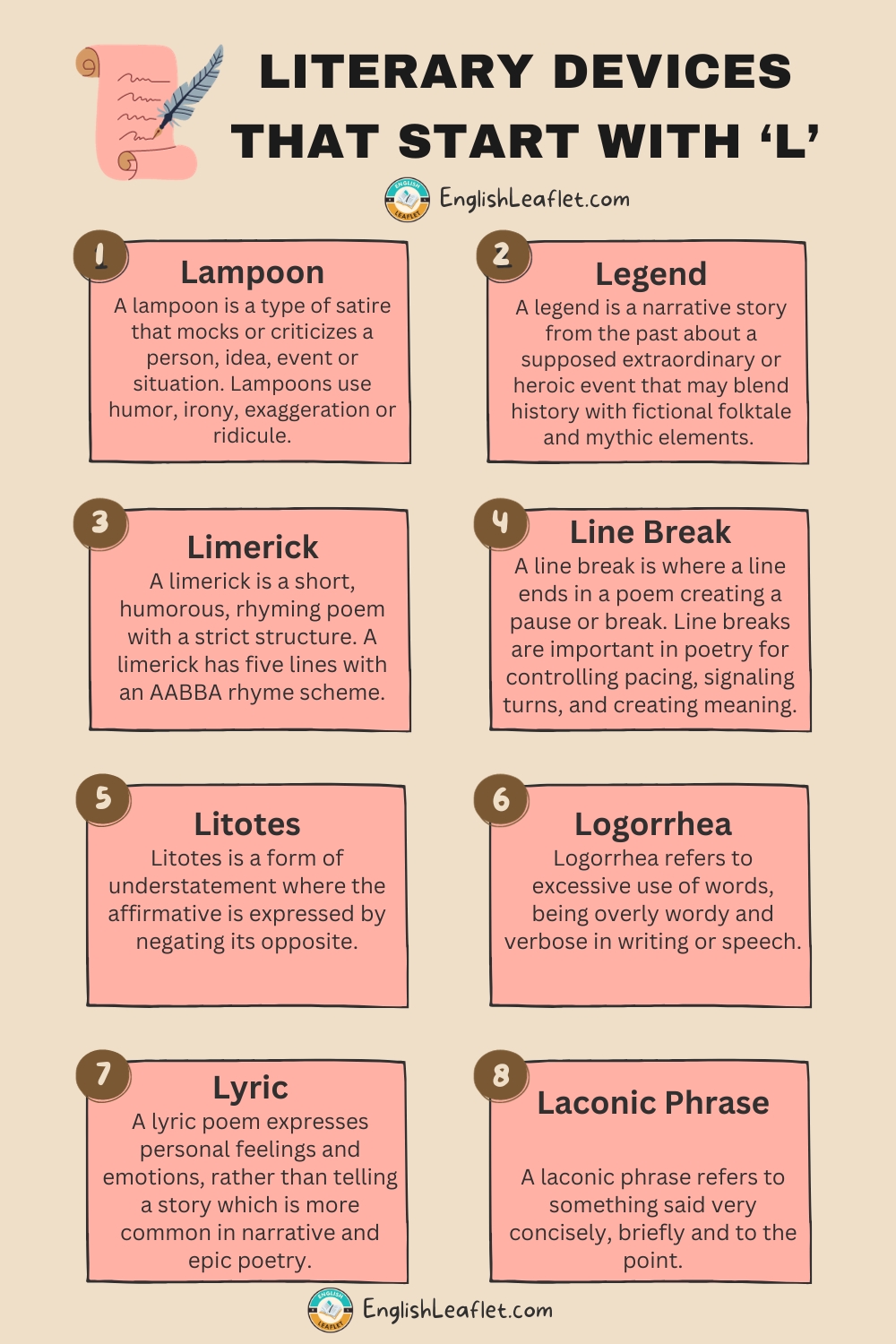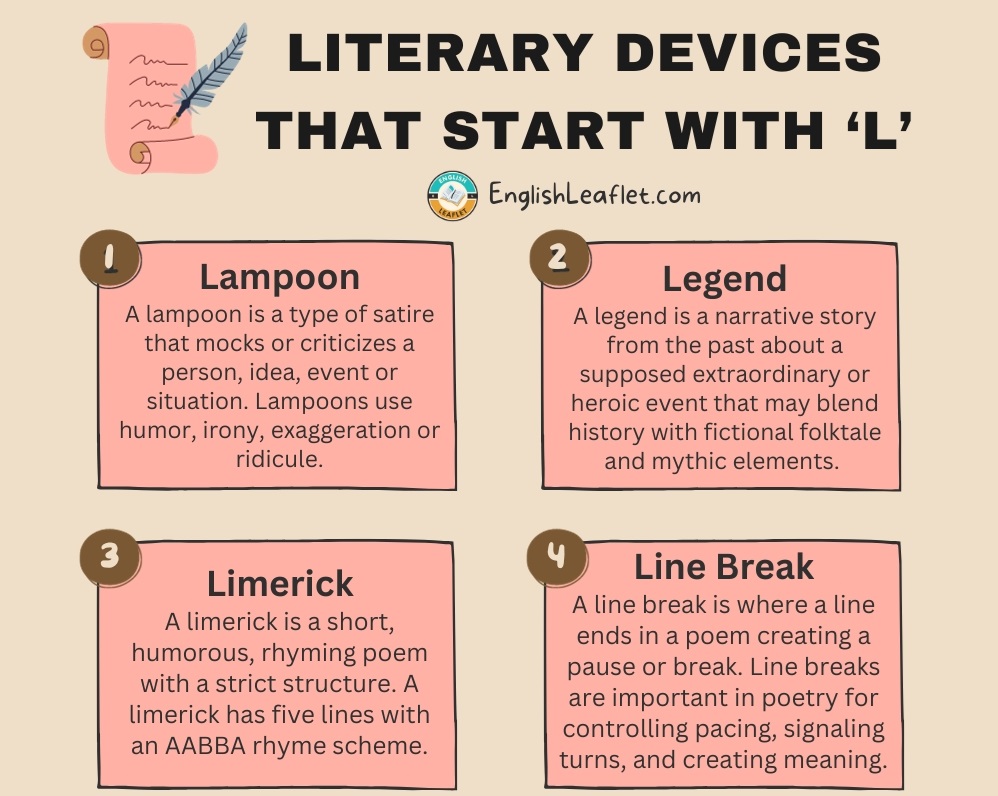There is a vast formation of literary devices. Each device has its own unique function and impact. There are several important literary devices that start with L. These devices are: alliteration, logos, lampoon, litotes and many more. The writers while using these literary elements evoke emotions, convey messages and captivate readers through the artful use of language.
Here are some of the most prominent ones:
1- Lampoon
A lampoon is a type of satire that mocks or criticizes a person, idea, event or situation. Lampoons use humor, irony, exaggeration or ridicule. Some examples are parody songs, satirical cartoons, and mockery in pop culture.
Examples in literature
“Gulliver’s Travels” by Jonathan Swift
The satirical work of the writer is a classic example of lampoon. In the land of Lilliput, the author lampoons the British government and society by using diminutive people to represent real life figures. He portrays the absurdity of political disputes and vanities through tiny characters. The writer offers a sharp critique of 18th century England.
“Animal Farm” by George Orwell
The ‘Animal Farm’ is a allegorical novella. The writer lampoons the events which are leading to the Russian Revolution. He depicts animals who overthrow their human masters and establish their own oppressive society. Orwell satirizes the corrupted ideals of the revolution and the rise of authoritarianism.
2- Legend
A legend is a narrative story from the past about a supposed extraordinary or heroic event that may blend history with fictional folktale and mythic elements. Legends are passed down orally over generations. Examples are the Legend of King Arthur and Robin Hood.
Examples in literature
“Le Morte d’Arthur” by Sir Thomas Malory
In Malory’s work, the legend of King Arthur and the Knights of the Round Table is central. These legendary characters and their quests form the foundation of Arthurian literature. The legends of King Arthur have inspired numerous retellings, adaptations, and reinterpretations in literature.
“The Iliad” and “The Odyssey” by Homer
The epic poems of Homer are filled with legends of gods, heroes and epic battles. The Trojan War and the adventures of Odysseus are of them. These are based on ancient Greek legends. The legends have not only shaped Greek literature but have had a profound influence on Western literature and storytelling as a whole.
3- Limerick
A limerick is a short, humorous, rhyming poem with a strict structure. A limerick has five lines with an AABBA rhyme scheme. The rhyme and rhythm give limericks a musical, comedic quality.
Examples in Literature
Here are examples of limericks:
“There once was a man from Peru”
There once was a man from Peru,
Who dreamt he was eating his shoe,
He awoke with a fright,
In the middle of the night,
To find that his dream had come true.
“The Limerick”
There once was a limerick quite neat,
With a rhythm and rhyme that’s hard to beat,
A humorous jest,
In five lines expressed,
It’s a form that’s undeniably sweet.
“A canner, exceedingly canny”
A canner, exceedingly canny,
One morning remarked to his granny,
A canner can can,
Anything that he can,
But a canner can’t can a can, can he?
“There once was a man from the coast”
There once was a man from the coast,
Whose poems and limericks most,
Were funny and clever,
Lasting forever,
For laughter’s the thing I love most.
4- Line Break
A line break is where a line ends in a poem creating a pause or break. Line breaks are important in poetry for controlling pacing, signaling turns, and creating meaning. Line breaks utilize the white space between lines as a punctuation tool.
Examples in Literature
“Hope is the thing with feathers” by Emily Dickinson
“Hope is the thing with feathers
That perches in the soul,
And sings the tune without the words,
And never stops at all“
Emily uses line breaks in this poem to create a sense of rhythm and to emphasize the idea that, hope is a continuous and enduring presence in the human soul.
“somewhere i have never travelled, gladly beyond” by E.E. Cummings
“somewhere i have never travelled, gladly beyond
any experience, your eyes have their silence:
in your most frail gesture are things which enclose me,
or which i cannot touch because they are too near”
The writer is known for his unique use of line breaks and unconventional punctuation. In this poem, the line break serves to create a sense of wonder and intimacy while emphasizing the idea of exploring new, uncharted territory in a relationship.
“Because I could not stop for Death” by Emily Dickinson
“Because I could not stop for Death,
He kindly stopped for me,
The Carriage held but just Ourselves,
And Immortality.“
Emily uses line breaks to control the flow of the poem. She emphasizes the pause in the first line to convey the surprise of being visited by Death. The en dash in the first line also serves as a visual and rhythmic pause, which draw attention to the word “because.” The line breaks create a measured and reflective pace, which allows the reader to consider the journey with Death.
5- Litotes
Litotes is a form of understatement where the affirmative is expressed by negating its opposite. For example:
- He’s not a bad player = He’s a good player
- This is no small problem = This is a big problem
Litotes emphasizes a point by intentionally understating the case.
Examples in Literature
“A Tale of Two Cities” by Charles Dickens
“It was the best of times, it was the worst of times, it was the age of wisdom, it was the age of foolishness, it was the epoch of belief, it was the epoch of incredulity, it was the season of Light, it was the season of Darkness, it was the spring of hope, it was the winter of despair.”
The opening lines of the novel demonstrates about litotes, which emphasizes the extreme division between London and Paris during the French Revolution:
Dickens employs litotes to emphasize the stark contrast between the two cities and the eras in which the novel is set. He uses phrases like “it was the worst of times” and “the season of Darkness,” in order to downplay the positive aspects, and to underscore the depth of despair experience during that period.
“Julius Caesar” by William Shakespeare
In this play of Shakespeare, Mark Antony uses litotes to manipulate the crowd’s emotions. Speaking of Caesar’s will: “If you have tears, prepare to shed them now.” He says “prepare to shed them now,”. He understates the audience’s emotional response, which hope to provoke an even greater reaction.
6- Logorrhea
Logorrhea refers to excessive use of words, being overly wordy and verbose in writing or speech. For example:
- The politician’s speech was full of logorrhea that failed to get to the point.
- The student’s essay was verbose logorrhea and omitted the main ideas.
Examples in literature
“The Sound and the Fury” by William Faulkner
In the novel, a part of the story has been told by Benjy, a character with a cognitive disability. Benjy’s way of telling the story is quite wordy and disorganized. His thoughts and feelings are jumble together. He does not use regular punctuation or structure. Here’s an excerpt:
“Trees shadowing the dust road, the late formal honeysuckle, dark, dust glistening, the road grey now with dust, long hot drowsy summer afternoon with the early gold of the light in the tree.”
The narrative of the Benjey reflects his limited ability to communicate in a coherent and concise manner. His logorrheic style allows readers to immerse themselves in his fragmented and sensory driven experience of the world. The excessive wordiness and lack of traditional sentence structure mirror Benjy’s internal thoughts and struggles with language.
“Ulysses” by James Joyce
In this novel, the character Leopold Bloom encounters a man named Blazes Boylan who exhibits logorrhea as he rambles on in a pub about various topics. Bloom’s reaction to Boylan’s verbosity is notable as he contemplates the significance of the conversation. The logorrhea in this passage serves to highlight the mundane and trivial nature of the discussion, which contrasts with Bloom’s inner reflections.
7- Lyric
A lyric poem expresses personal feelings and emotions, rather than telling a story which is more common in narrative and epic poetry. Lyrics often use devices like rhyme, meter and imaginative language.
Examples in literature
“I Wandered Lonely as a Cloud” by William Wordsworth
“Continuous as the stars that shine
And twinkle on the Milky Way,
They stretched in never-ending line
Along the margin of a bay:
Ten thousand saw I at a glance,
Tossing their heads in sprightly dance.”
Wordsworth reflects on the beauty of a field of daffodils. He encounters during a solitary walk. The poem’s emotional depth and vivid imagery capture the awe and wonder he experienced, which make it a quintessential example of the lyric form. Lyric poetry is known for its exploration of personal emotions and experiences. Wordsworth’s poem does just that by conveying his sense of awe and connection to the natural world.
“Dreams” by Langston Hughes
“Hold fast to dreams
For if dreams die
Life is a broken-winged bird
That cannot fly.”
Langston poem “Dreams” captures the importance of holding on to one’s dreams and aspirations. The poem’s emotional and inspirational content is a hallmark of lyric poetry.
8- Laconic Phrase
A laconic phrase refers to something said very concisely, briefly and to the point. For example:
- When asked why he robs banks, the laconic answer was “That’s where the money is.”
- Faced with surrender, the general’s laconic reply was simply: “Nuts.”
Examples in literature
“Hamlet” by William Shakespeare
“Neither a borrower nor a lender be.”
In this famous line, Polonius, a character in “Hamlet,” offers a piece of advice to his son, Laertes. The phrase is laconic, which emphasizes the wisdom of avoiding financial transactions with friends and family as they can strain relationships. This brief statement carries a universal and timeless message about money matters and the potential consequences.
“Animal Farm” by George Orwell
“All animals are equal, but some animals are more equal than others.”
This laconic phrase is one of the central principles put forth by the pigs who take over the farm in Orwell’s allegorical novella. It satirizes the idea of equality and underscores the hypocrisy and corruption of those in power.

More to read
- Literary Devices (A – Z List)
- Literary Devices That Start with A
- Literary Devices That Start with B
- Literary Devices that Start with C
- Literary Devices that Start with D
- Literary Devices that Start with E
- Literary Devices that Start with F
- Literary Devices that Start with H
- Literary Devices that Start with I
- Literary Devices that Start with K

